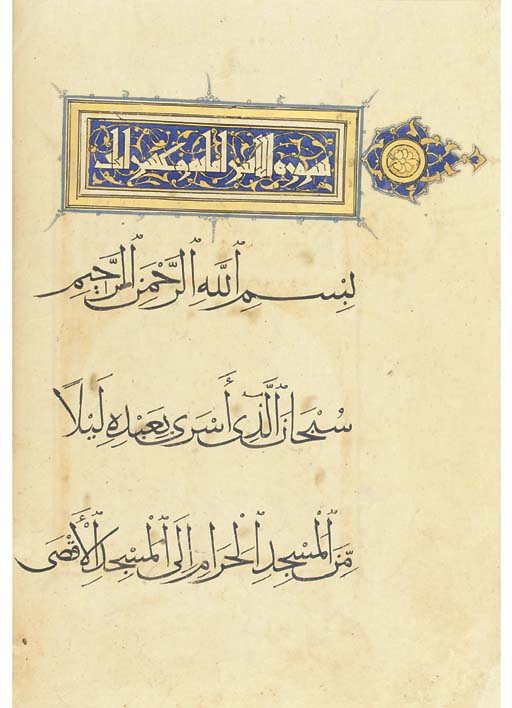

A leaf from a 14th-century Mamluk Egyptian Qur'an
Source: http://www.christies.com/LotFinder/search/LotDetail.asp?sid=&intObjectID=4483305&SE=CMWCAT03+628772+1898125640+&QR=M+1+0+Aqc0000900+611418++Aqc0000900+&entry=islamic&T=Lot&SU=1&RQ=False&AN=1
(downloaded Apr. 2005)
"QUR'AN JUZ' XV, PART 1, MAMLUK EGYPT, 14TH CENTURY. Manuscript on paper, Qur'an XVII surat bani isra'il vv.1-50, missing vv.14-24, 13ff. with 4ll. of black muhaqqaq, gold and blue rosette verse markers, gold kufic 'ashr markers in blue roundels, illuminated title page with white kufic inscription al-juz' al-khamas 'ashr reserved on blue ground with spiralling gold arabesque, below an inscription in gold thuluth within arched panel over white arabesques with blue and brown highlights reserved on red hatched ground, all in gold frame with marginal medallion, sura heading with similar white kufic over blue ground in gold frame with marginal blue and gold arabesque panel, contemporary brown morocco binding with blind-tooled geometric decoration, slight repairs to corners of some pages, spine and doublures repaired, trace of waqf inscription. Folio 10 x 6 7/8 in. (25.5 x 17.5cm)
Lot Notes: Two folios from this Qu'ran are in the Nasser D. Khalili Collection. One is illustrated in James, David :The Master Scribes Oxford, 1992, no.39, p.159. It is catalogued there as coming from a 30-part Qur'an, but the inscription in the roundel on folio 1r. of the present volume states that it contains juz' XV Part 1- half of a juz', so it is possible that this was a 60-volume manuscript.
Other folios from the same Qur'an are in the Chester Beatty Library,
Dublin, MS. 1461, and the Muhammad Mahdi al-Tajir Collection, which has
Parts 22 and 24. Part 24 was exhibited at the British Library for the World
of Islam festival, 1976, and is illustrated in the catalogue, Lings, M.
and Safadi, Y.:The Qur'an, Westerham, 1976, no. 78, p.55."

A Mamluk prayer-book from Egypt, c.1496
Source: http://www.christies.com/LotFinder/search/LotDetail.asp?sid=&intObjectID=4483344&SE=CMWCAT03+628842+1899798234+&QR=M+1+39+Aqc0000900+611483++Aqc0000900+&entry=islamic&T=Lot&SU=1&RQ=True&AN=40
(downloaded Apr. 2005)
"HAZRAT IMAM SALIH SHARAF AL-DIN ABU 'ABD ALLAH MUHAMMAD B. HASSAN AL-BUSAIRI: QASIDAT AL-BURDA. COPIED AND ILLUMINATED BY YASHBAK B. 'ABD ALLAH AL-'ALAAI IN DAMASCUS, MAMLUK SYRIA, CIRCA AH 901-904/1496-98 AD. Poetry in praise of the Prophet Muhammad. Arabic manuscript on thick cream paper, 29ff., three panels each containing three lines of small naskh in black and red, flanked on each side by a line of diagonally written naskh and divided by three lines of large bold black muhaqqaq, gold, red and blue rosettes, all within gold, blue and black rules, opening with a large dedicatory medallion to Muhammad b. Sultan Qaitbay with a line of white thuluth above and below on gold clouds against green ground, below a dedicatory inscription to Qansawh in similar script, facing page with 11ll. of small black naskh in clouds over red hatched ground, in gold and blue illuminated frame, the opening of the main text with headpiece of white thuluth over gold scrolling arabesque on blue ground in gold frame, the bismallah outlined in gold, final page with colophon naming the scribe and the place medinat al-shams (Damascus), slight retouching on dedicatory inscription, slight wear, later red morocco Ottoman binding and case. Folio 15¾ x 12in. (40 x 30.5cm.).
Lot Notes: The writer of this celebrated poem Al-Busairi had become paralysed and physicians had given up hope of his recovery. While in despair he composed this poem in praise of the Prophet Muhammad. He then isolated himself and recited the poem. While reciting he fell asleep and is said to have had a vision in which he spoke to the Prophet. When he awoke he found the around him the mantle that the Prophet had been wearing in his dream. He had a miraculous recovery and therefore called this work Qasidat al-Burda, (The Poem of the Mantle). See Encyclopaedia of Islam, Vol.1, Leiden, 1986 pp.1314-15.
The dedicatory inscriptions on this manuscript relates to Al-Nasr Muhammad
VI b. Qaitbay (r. AH 901-904/1496-98 AD) and his successor Al-Zahir Qansawh
I (r. AH 904-905/1498-1500 AD). Most likely it was copied during short
the reign of the former, which dates the manuscript fairly precisely. The
dedication to Qansawh would have been a slightly later ammendment to honour
the new Sultan."